water pump YAMAHA FX SVHO 2014 Owners Manual
[x] Cancel search | Manufacturer: YAMAHA, Model Year: 2014, Model line: FX SVHO, Model: YAMAHA FX SVHO 2014Pages: 118, PDF Size: 5.89 MB
Page 6 of 118

Table of contents
Transporting on a trailer ................ 63
First-time operation ........................ 64 Engine break-in ............................. 64
Pre-operation checks ..................... 65
Pre-operation checklist .................... 65
Pre-operation check points........... 67
Pre-launch checks ........................... 67
Post-launch checks ......................... 74
Operation ......................................... 76 Operating your watercraft ............. 76
Getting to know your watercraft ...... 76
Learning to operate your
watercraft ...................................... 76
Riding position ................................. 77
Launching the watercraft ................. 77
Starting the engine on water ............ 77
Stopping the engine ......................... 78
Leaving the watercraft...................... 78
Operating the watercraft .................. 78
Turning the watercraft ...................... 79
Stopping the watercraft ................... 80
Operating the watercraft in reverse or neutral....................................... 81
Boarding the watercraft ................... 82
Starting off........................................ 85
Capsized watercraft ......................... 86
Beaching and docking the
watercraft ...................................... 87
Operating in weeded areas .............. 87
After removing the watercraft from the water ....................................... 88
Care and storage............................. 89Post-operation care ...................... 89
Flushing the cooling water
passages....................................... 89
Cleaning the watercraft .................... 90
Battery care ...................................... 90
Long-term storage ........................ 93
Cleaning ........................................... 93
Lubrication ....................................... 93 Rustproofing ..................................... 94
Maintenance .................................... 95
Maintenance ................................. 95
Tool kit.............................................. 95
Removing and installing the engine
cover ............................................. 95
Periodic maintenance chart ............. 97
Engine oil and oil filter ...................... 99
Specifications ................................ 100 Specifications ............................. 100
Trouble recovery ........................... 101 Troubleshooting .......................... 101
Troubleshooting chart .................... 101
Emergency procedures .............. 104
Cleaning the jet intake and
impeller ....................................... 104
Jumping the battery ....................... 105
Replacing the fuses ........................ 105
Replacing the bilge pump fuse ...... 107
Towing the watercraft..................... 108
Submerged watercraft ................... 109
UF3J70E0.book Page 2 Wednesd ay, October 9, 2013 2:07 PM
Page 22 of 118

Safety information
16
EJU42472
Hazard information
Never start the engine or let it run for any
length of time in an enclosed area. Exhaust
fumes contain carbon monoxide, a color-
less, odorless gas that may cause loss of
consciousness and death within a short
time. Always operate the watercraft in an
open area.
Do not touch the hot muffler or engine dur-
ing or immediately after engine operation;
they can cause serious burns.
Do not place magnets or objects with a
strong magnetic force near the throttle le-
ver. The electronic throttle mechanism can
be adversely affected, which could cause
loss of control. In addition, do not place ob-
jects susceptible to magnetic forces (i.e.,
credit cards, watches, etc.) close to the
throttle lever.
EJU42412
Watercraft characteristics
Jet thrust turns the watercraft. Releasing
the throttle lever completely produces only
minimum thrust. If you are traveling at
speeds above trolling, you will have rapidly
decreasing ability to steer without throttle.
This model is equipped with the Yamaha
Engine Management System (YEMS) that
includes an off-throttle steering (OTS) sys-
tem. It will activate at planing speeds
should you attempt to steer the watercraft
after releasing the throttle lever. The OTS
system assists in turning by continuing to
supply some thrust while the watercraft is
decelerating, but you can turn more sharp-
ly if you apply throttle while turning the han-
dlebars.
The OTS system does not function below
planing speeds or when the engine is off.
Once the engine slows down, the water-
craft will no longer turn in response to han-
dlebar input until you apply throttle again or
you reach trolling speed.
Practice turning in an open area without
obstacles until you have a good feel for this
maneuver.
This watercraft is water-jet propelled. The
jet pump is directly connected to the en-
gine. This means that jet thrust will produce
some movement whenever the engine is
running and the shift lever is in the forward
or reverse position. The neutral position
balances forward and reverse thrust to
help keep the watercraft from moving in ei-
ther direction, although some movement
may occur.
Do not use the reverse function to slow
down or stop the watercraft as it could
UF3J70E0.book Page 16 Wednesday, October 9, 2013 2:07 PM
Page 64 of 118

Operation and handling requirements
58
EJU31823
Fuel requirementsEJU42721Fuel
WARNING
EWJ00283
Gasoline and gasoline vapors are ex-
tremely flammable. To avoid fires and
explosions and to reduce the risk of in-
jury when refueling, follow these in-
structions.
Gasoline is poisonous and can cause in-
jury or death. Handle gasoline with care.
Never siphon gasoline by mouth. If you
should swallow some gasoline, inhale a
lot of gasoline vapor, or get some gaso-
line in your eyes, see your doctor imme-
diately. If gasoline spills on your skin,
wash with soap and water. If gasoline
spills on your clothing, change your
clothes.
NOTICE
ECJ01870
Do not use leaded gasoline. Leaded
gasoline can seriously damage the en-
gine.
Avoid getting water and contaminants in
the fuel tank. Contaminated fuel can
cause poor performance and engine
damage. Use only fresh gasoline that
has been stored in clean containers.
Use only gasoline with a minimum pump
octane number of 91 or a minimum re-
search octane number of 95. Low-oc-
tane gasoline can seriously damage the
engine.
Your Yamaha engine has been designed to
use premium unleaded gasoline with a pump
octane number [(R+M)/2] of 91 or higher, or a
research octane number of 95 or higher. Ifknocking (or pinging) occurs, use a gasoline
of a different brand.
Gasohol
There are two types of gasohol: gasohol con-
taining ethanol and that containing methanol.
Gasohol containing ethanol can be used if
ethanol content does not exceed 10% and
the fuel meets the minimum octane ratings.
E-85 is a fuel blend containing 85% ethanol
and therefore must not be used in this water-
craft. All ethanol blends containing more than
10% ethanol can cause fuel system damage
or engine performance problems.
Yamaha does not recommend gasohol con- taining methanol because it can cause fuel
system damage and engine performance
problems.
To fill the fuel tank:
(1) Before refueling, stop the engine. Do not stand or sit on the watercraft. Never refu-
el while smoking, or while in the vicinity
of sparks, open flames, or other sources
of ignition.
(2) Place the watercraft in a well-ventilated area and in a horizontal position.
(3) Remove the seats, and then check the fuel level. (See page 49 for seat removal
and installation procedures.)
Recommended fuel:
Premium unleaded gasoline with a
minimum octane rating of 91
(Pump octane number) = (R + M)/2
95 (Research octane number)
UF3J70E0.book Page 58 Wednesd ay, October 9, 2013 2:07 PM
Page 68 of 118

Operation and handling requirements
62
maining moisture in the engine compart-
ment with a dry cloth.
(4) Securely install the stern drain plugs by tightening them until they stop. NOTICE:
Before installing the stern drain plugs,
clean the drain plug threads and the
O-rings on the plugs to remove any
foreign materials, such as dirt or sand.
Otherwise, the stern drain plugs could
be damaged, allowing water to enter
the engine compartment. Check the
O-rings on the stern drain plugs and
make sure that the plugs are tightened
securely before launching the water-
craft. Otherwise, water may flood the
engine compartment and cause the
watercraft to submerge.
[ECJ00363]
EJU42171
Draining the bilge water on water
A small quantity of bilge water will remain in
the engine compartment even after the bilge
water is drained on water. To completely
drain the bilge water, remove the watercraft
from the water and drain the bilge water on
land.
Jet vacuum bilge draining system
While the watercraft is operating, bilge water
in the engine compartment is drawn in by the
vacuum that is generated in the jet pump and
discharged from the watercraft through the
jet thrust nozzle.
To drain the bilge water on water:
Operate the watercraft as straight as possible
and above planing speed for at least 2 min-
utes. NOTICE: Do not run the engine at full
throttle for at least 1 minute after the en-
gine has been restarted. Bilge water in the
engine compartment can splash into the engine, which can result in severe dam-
age.
[ECJ00554]
Electric bilge draining system
Bilge water in the engine compartment is
drawn in by the operation of the electric bilge
pump and discharged from the watercraft.
To drain the bilge water:
Start the engine to operate the electric bilge
pump.
TIP:
The electric bilge pump continues to operate
for a short time after the engine stops.
UF3J70E0.book Page 62 Wednesd
ay, October 9, 2013 2:07 PM
Page 85 of 118

Operation
79
32 for information on operating the shift le-
ver.)
EJU33255Turning the watercraft
WARNING
EWJ00772
Do not release the throttle lever when
trying to steer away from objects—you
need throttle to steer. A collision could
result in severe injury or death.
When operating at higher speeds, make
gradual turns or slow down before turn-
ing. Sharp high-speed turns may cause
the watercraft to slide sideways or spin,
throwing the operator and passenger(s)
overboard, which could cause an injury.
Steering control depends on the combination
of handlebar position and the amount of
throttle.Water sucked in through the intake grate is
pressurized by the impeller in the jet pump.
As the pressurized water is expelled from the
pump through the jet thrust nozzle, it creates
thrust to move and steer the watercraft. The
higher the engine speed, the more thrust pro-
duced.
The amount of jet thrust, in addition to the po-
sition of the handlebars, determines how
sharply you turn.
A. More throttle produces higher thrust, so
the watercraft will turn more sharply.
B. Less throttle produces lower thrust, so the watercraft will turn more gradually.
C. Releasing the throttle lever completely produces only minimum thrust. If you are
traveling at speeds above trolling, you
will have rapidly decreasing ability to
steer without throttle. You may still have
some turning ability immediately after re-
leasing the throttle lever, but once the
1Shift lever
2 Forward position
1
2
UF3J70E0.book Page 79 Wednesd ay, October 9, 2013 2:07 PM
Page 95 of 118
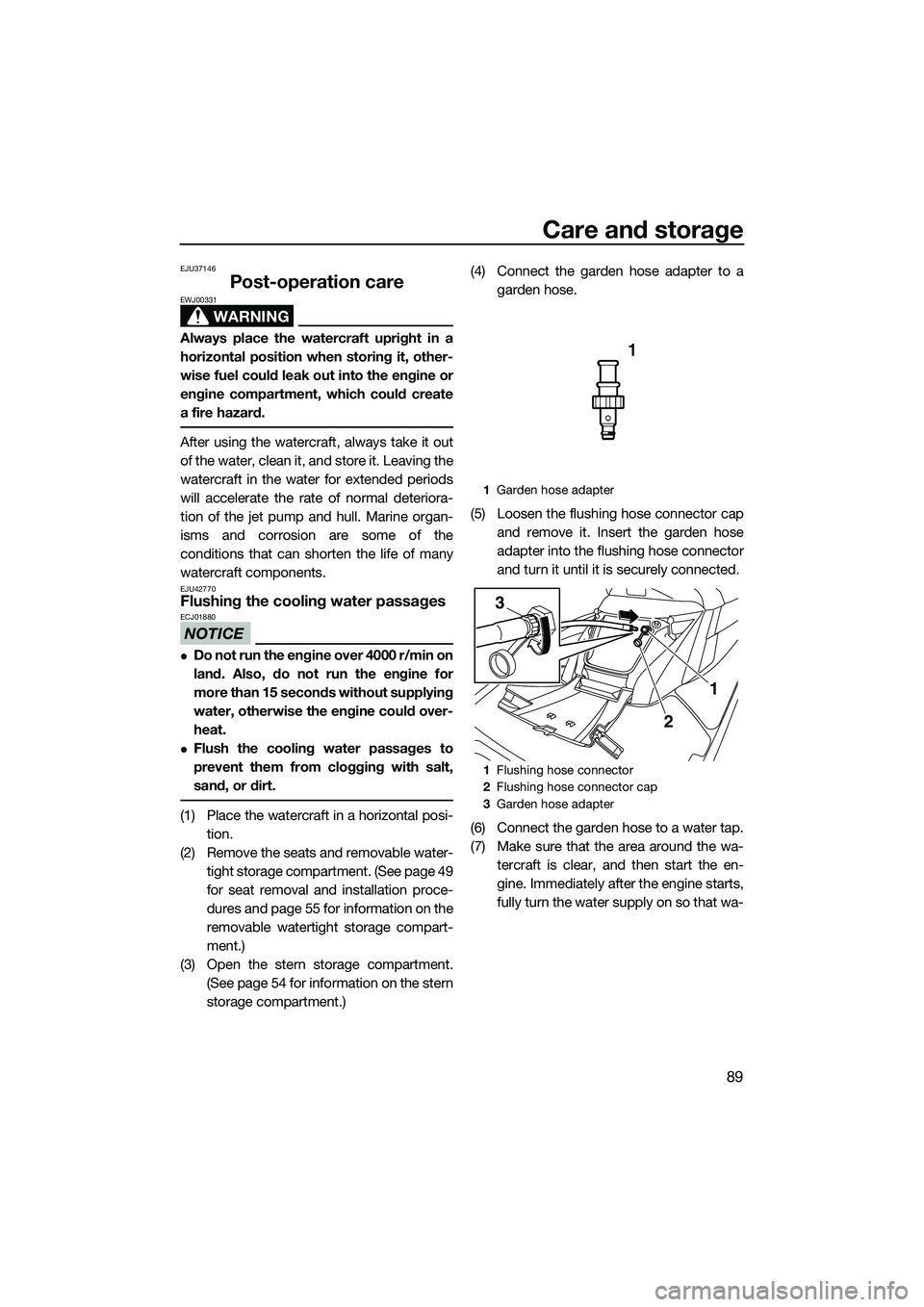
Care and storage
89
EJU37146
Post-operation care
WARNING
EWJ00331
Always place the watercraft upright in a
horizontal position when storing it, other-
wise fuel could leak out into the engine or
engine compartment, which could create
a fire hazard.
After using the watercraft, always take it out
of the water, clean it, and store it. Leaving the
watercraft in the water for extended periods
will accelerate the rate of normal deteriora-
tion of the jet pump and hull. Marine organ-
isms and corrosion are some of the
conditions that can shorten the life of many
watercraft components.
EJU42770Flushing the cooling water passages
NOTICE
ECJ01880
Do not run the engine over 4000 r/min on
land. Also, do not run the engine for
more than 15 seconds without supplying
water, otherwise the engine could over-
heat.
Flush the cooling water passages to
prevent them from clogging with salt,
sand, or dirt.
(1) Place the watercraft in a horizontal posi-tion.
(2) Remove the seats and removable water- tight storage compartment. (See page 49
for seat removal and installation proce-
dures and page 55 for information on the
removable watertight storage compart-
ment.)
(3) Open the stern storage compartment. (See page 54 for information on the stern
storage compartment.) (4) Connect the garden hose adapter to a
garden hose.
(5) Loosen the flushing hose connector cap and remove it. Insert the garden hose
adapter into the flushing hose connector
and turn it until it is securely connected.
(6) Connect the garden hose to a water tap.
(7) Make sure that the area around the wa- tercraft is clear, and then start the en-
gine. Immediately after the engine starts,
fully turn the water supply on so that wa-
1Garden hose adapter
1 Flushing hose connector
2 Flushing hose connector cap
3 Garden hose adapter
1
3
2
UF3J70E0.book Page 89 Wednesd ay, October 9, 2013 2:07 PM
Page 96 of 118
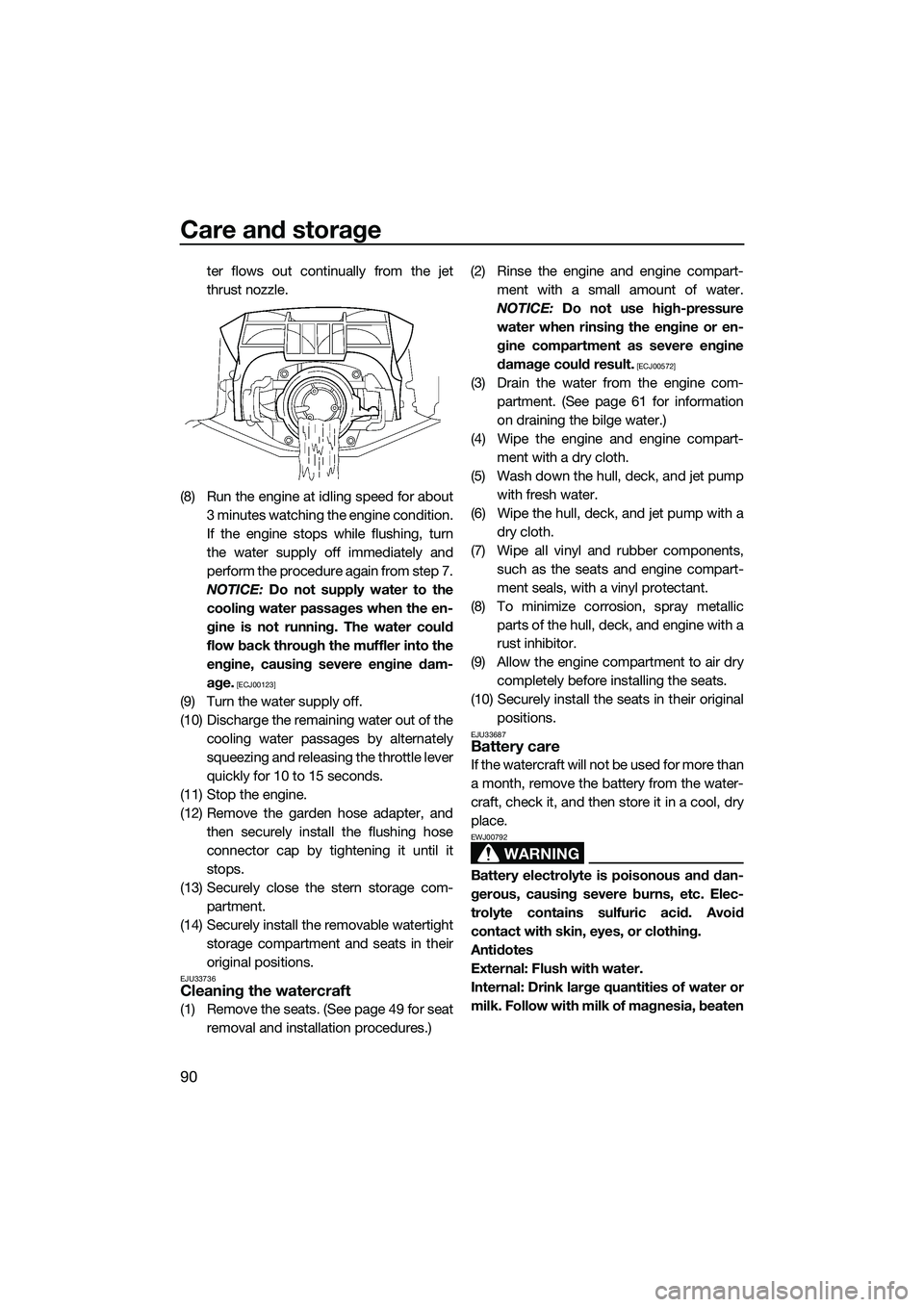
Care and storage
90
ter flows out continually from the jet
thrust nozzle.
(8) Run the engine at idling speed for about 3 minutes watching the engine condition.
If the engine stops while flushing, turn
the water supply off immediately and
perform the procedure again from step 7.
NOTICE: Do not supply water to the
cooling water passages when the en-
gine is not running. The water could
flow back through the muffler into the
engine, causing severe engine dam-
age.
[ECJ00123]
(9) Turn the water supply off.
(10) Discharge the remaining water out of the cooling water passages by alternately
squeezing and releasing the throttle lever
quickly for 10 to 15 seconds.
(11) Stop the engine.
(12) Remove the garden hose adapter, and then securely install the flushing hose
connector cap by tightening it until it
stops.
(13) Securely close the stern storage com- partment.
(14) Securely install the removable watertight storage compartment and seats in their
original positions.
EJU33736Cleaning the watercraft
(1) Remove the seats. (See page 49 for seatremoval and installation procedures.) (2) Rinse the engine and engine compart-
ment with a small amount of water.
NOTICE: Do not use high-pressure
water when rinsing the engine or en-
gine compartment as severe engine
damage could result.
[ECJ00572]
(3) Drain the water from the engine com- partment. (See page 61 for information
on draining the bilge water.)
(4) Wipe the engine and engine compart- ment with a dry cloth.
(5) Wash down the hull, deck, and jet pump with fresh water.
(6) Wipe the hull, deck, and jet pump with a dry cloth.
(7) Wipe all vinyl and rubber components, such as the seats and engine compart-
ment seals, with a vinyl protectant.
(8) To minimize corrosion, spray metallic parts of the hull, deck, and engine with a
rust inhibitor.
(9) Allow the engine compartment to air dry completely before installing the seats.
(10) Securely install the seats in their original positions.
EJU33687Battery care
If the watercraft will not be used for more than
a month, remove the battery from the water-
craft, check it, and then store it in a cool, dry
place.
WARNING
EWJ00792
Battery electrolyte is poisonous and dan-
gerous, causing severe burns, etc. Elec-
trolyte contains sulfuric acid. Avoid
contact with skin, eyes, or clothing.
Antidotes
External: Flush with water.
Internal: Drink large quantities of water or
milk. Follow with milk of magnesia, beaten
UF3J70E0.book Page 90 Wednesd ay, October 9, 2013 2:07 PM
Page 106 of 118
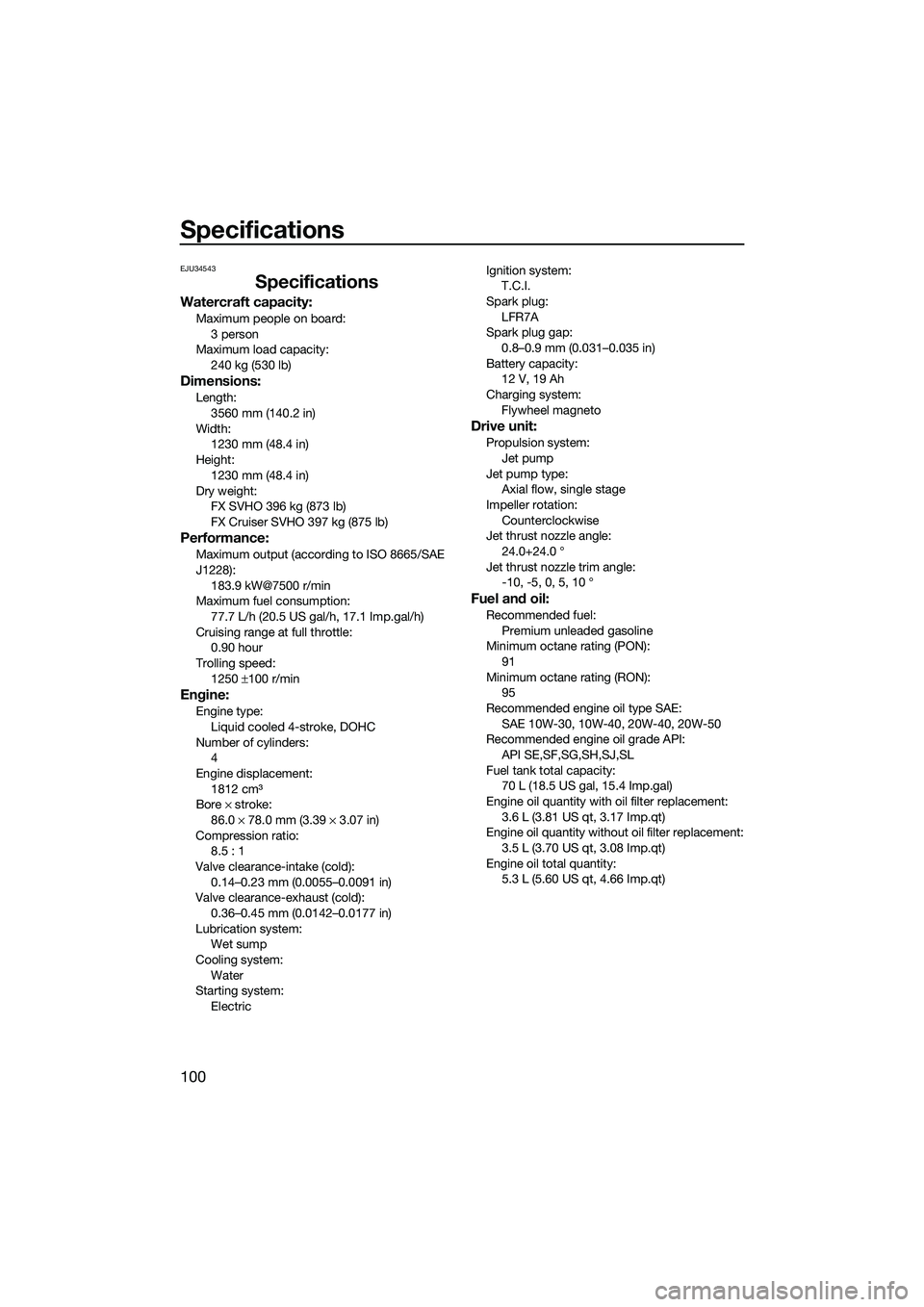
Specifications
100
EJU34543
Specifications
Watercraft capacity:
Maximum people on board:3 person
Maximum load capacity: 240 kg (530 lb)
Dimensions:
Length:
3560 mm (140.2 in)
Width: 1230 mm (48.4 in)
Height: 1230 mm (48.4 in)
Dry weight: FX SVHO 396 kg (873 lb)
FX Cruiser SVHO 397 kg (875 lb)
Performance:
Maximum output (according to ISO 8665/SAE
J1228):183.9 kW@7500 r/min
Maximum fuel consumption:
77.7 L/h (20.5 US gal/h, 17.1 Imp.gal/h)
Cruising range at full throttle: 0.90 hour
Trolling speed: 1250 ±100 r/min
Engine:
Engine type:
Liquid cooled 4-stroke, DOHC
Number of cylinders: 4
Engine displacement:
1812 cm³
Bore × stroke:
86.0 × 78.0 mm (3.39 × 3.07 in)
Compression ratio: 8.5 : 1
Valve clearance-intake (cold):
0.14–0.23 mm (0.0055–0.0091 in)
Valve clearance-exhaust (cold): 0.36–0.45 mm (0.0142–0.0177 in)
Lubrication system: Wet sump
Cooling system:
Water
Starting system: Electric Ignition system:
T.C.I.
Spark plug: LFR7A
Spark plug gap:
0.8–0.9 mm (0.031–0.035 in)
Battery capacity: 12 V, 19 Ah
Charging system: Flywheel magneto
Drive unit:
Propulsion system:Jet pump
Jet pump type: Axial flow, single stage
Impeller rotation: Counterclockwise
Jet thrust nozzle angle:
24.0+24.0 °
Jet thrust nozzle trim angle: -10, -5, 0, 5, 10 °
Fuel and oil:
Recommended fuel:
Premium unleaded gasoline
Minimum octane rating (PON): 91
Minimum octane rating (RON): 95
Recommended engine oil type SAE:
SAE 10W-30, 10W-40, 20W-40, 20W-50
Recommended engine oil grade API: API SE,SF,SG,SH,SJ,SL
Fuel tank total capacity: 70 L (18.5 US gal, 15.4 Imp.gal)
Engine oil quantity with oil filter replacement:
3.6 L (3.81 US qt, 3.17 Imp.qt)
Engine oil quantity without oil filter replacement: 3.5 L (3.70 US qt, 3.08 Imp.qt)
Engine oil total quantity: 5.3 L (5.60 US qt, 4.66 Imp.qt)
UF3J70E0.book Page 100 Wednesd ay, October 9, 2013 2:07 PM
Page 107 of 118
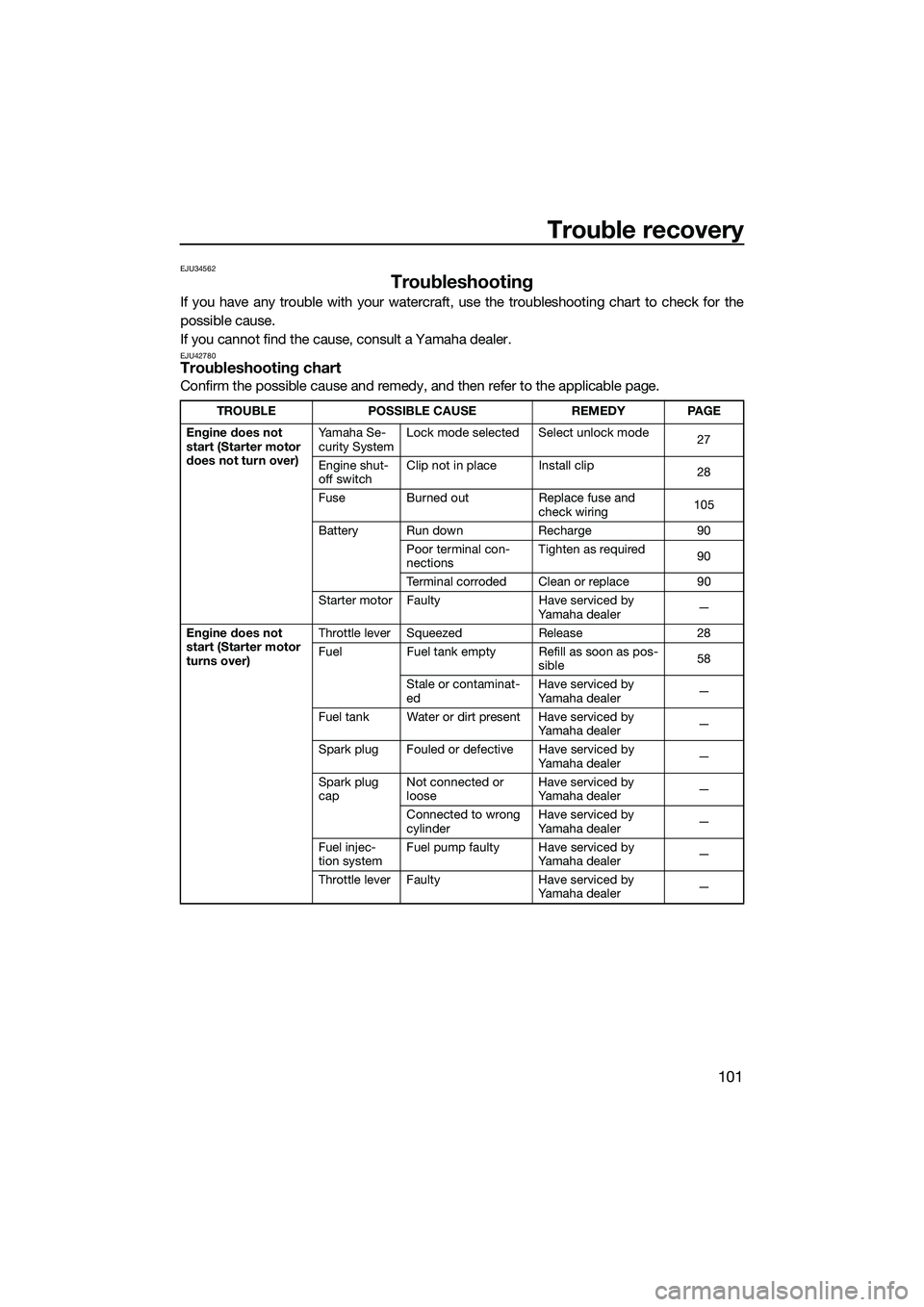
Trouble recovery
101
EJU34562
Troubleshooting
If you have any trouble with your watercraft, use the troubleshooting chart to check for the
possible cause.
If you cannot find the cause, consult a Yamaha dealer.
EJU42780Troubleshooting chart
Confirm the possible cause and remedy, and then refer to the applicable page.
TROUBLEPOSSIBLE CAUSE REMEDYPAGE
Engine does not
start (Starter motor
does not turn over) Ya m a h a S e -
curity System
Lock mode selected Select unlock mode
27
Engine shut-
off switch Clip not in place Install clip
28
Fuse Burned out Replace fuse and
check wiring 105
Battery Run down Recharge90
Poor terminal con-
nections Tighten as required
90
Terminal corroded Clean or replace 90
Starter motor Faulty Have serviced by
Yamaha dealer —
Engine does not
start (Starter motor
turns over) Throttle lever Squeezed
Release28
Fuel Fuel tank empty Refill as soon as pos-
sible 58
Stale or contaminat-
ed Have serviced by
Yamaha dealer
—
Fuel tank Water or dirt present Have serviced by Yamaha dealer—
Spark plug Fouled or defective Have serviced by Yamaha dealer—
Spark plug
cap Not connected or
loose Have serviced by
Yamaha dealer
—
Connected to wrong
cylinder Have serviced by
Yamaha dealer
—
Fuel injec-
tion system Fuel pump faulty Have serviced by
Yamaha dealer —
Throttle lever Faulty Have serviced by
Yamaha dealer —
UF3J70E0.book Page 101 Wednesd
ay, October 9, 2013 2:07 PM
Page 110 of 118
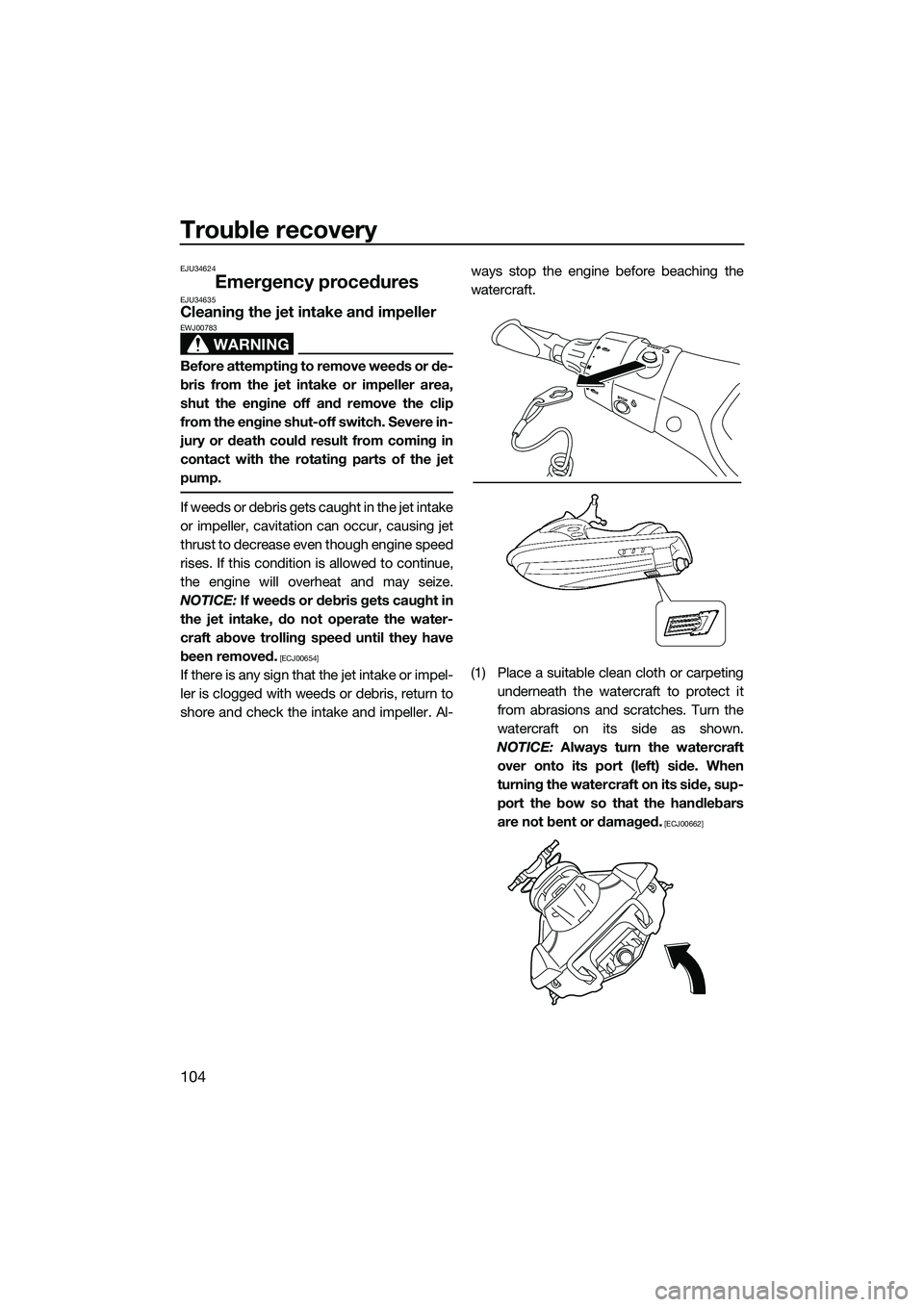
Trouble recovery
104
EJU34624
Emergency proceduresEJU34635Cleaning the jet intake and impeller
WARNING
EWJ00783
Before attempting to remove weeds or de-
bris from the jet intake or impeller area,
shut the engine off and remove the clip
from the engine shut-off switch. Severe in-
jury or death could result from coming in
contact with the rotating parts of the jet
pump.
If weeds or debris gets caught in the jet intake
or impeller, cavitation can occur, causing jet
thrust to decrease even though engine speed
rises. If this condition is allowed to continue,
the engine will overheat and may seize.
NOTICE: If weeds or debris gets caught in
the jet intake, do not operate the water-
craft above trolling speed until they have
been removed.
[ECJ00654]
If there is any sign that the jet intake or impel-
ler is clogged with weeds or debris, return to
shore and check the intake and impeller. Al- ways stop the engine before beaching the
watercraft.
(1) Place a suitable clean cloth or carpeting
underneath the watercraft to protect it
from abrasions and scratches. Turn the
watercraft on its side as shown.
NOTICE: Always turn the watercraft
over onto its port (left) side. When
turning the watercraft on its side, sup-
port the bow so that the handlebars
are not bent or damaged.
[ECJ00662]
UF3J70E0.book Page 104 Wednesd ay, October 9, 2013 2:07 PM